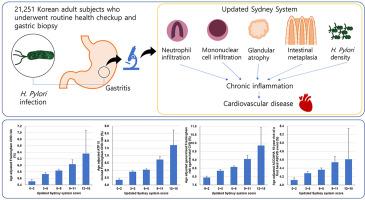Atherosclerosis ( IF 4.9 ) Pub Date : 2021-08-12 , DOI: 10.1016/j.atherosclerosis.2021.08.019 Jaehoon Chung 1 , Kyueng-Whan Min 2 , Byoung Kwan Son 3 , Dong-Hoon Kim 4 , Hack-Lyoung Kim 5

|
Background and aims
Although there have been several reports on the association between Helicobacter pylori (HP) infection and cardiovascular disease (CVD), most studies have been done through noninvasive testing such as serologic test or urea breath test. This study investigated the relationship between histological features of HP gastritis and cardiovascular risk scores.
Methods
A total of 21,251 subjects (mean age, 43.8 ± 9.6 years; males, 72.1%) who underwent routine health checkup and gastric biopsy were retrospectively analyzed. The severity of gastritis was assessed using the updated Sydney system (USS). With four different risk predicting algorithms, we calculated Framingham coronary heart disease (CHD) risk score, ATP III revised Framingham CHD risk score, generalized Framingham risk against total CVD, and ACC/AHA 10-year risk of a first hard atherosclerotic-CVD event in each subject.
Results
About half of the study subjects (51.2%, n = 10,890) were confirmed to have HP infection. Subjects with HP infection were younger (42.9 ± 9.0 vs. 44.7 ± 10.2 years, p < 0.001) than those without. After adjustment for age, most of the estimated 10-year cardiovascular risk increased as the grade of USS elements increased. As the sum of the USS scores increased, all the 4 estimated 10-year cardiovascular risk scores increased proportionally (p < 0.05 for each).
Conclusions
The histological features of gastritis assessed using USS were associated with various cardiovascular risk scores. This study provides strong evidence on an association between chronic inflammation and increased cardiovascular risk.
中文翻译:

韩国人群中幽门螺杆菌感染的组织学严重程度与心血管风险评分的相关性
背景和目标
尽管有一些关于幽门螺杆菌(HP) 感染与心血管疾病 (CVD)之间关联的报告,但大多数研究都是通过无创检测进行的,例如血清学检测或尿素呼气检测。本研究调查了 HP 胃炎的组织学特征与心血管风险评分之间的关系。
方法
对接受常规健康检查和胃活检的总共 21,251 名受试者(平均年龄,43.8 ± 9.6 岁;男性,72.1%)进行了回顾性分析。使用更新的悉尼系统 (USS) 评估胃炎的严重程度。使用四种不同的风险预测算法,我们计算了 Framingham 冠心病 (CHD) 风险评分、ATP III 修订的 Framingham CHD 风险评分、广义 Framingham 对总 CVD 的风险以及 ACC/AHA 10 年首次硬动脉粥样硬化性 CVD 事件的风险在每个科目中。
结果
大约一半的研究对象 (51.2%, n = 10,890) 被确认患有 HP 感染。感染 HP 的受试者 比没有感染的受试者更年轻(42.9 ± 9.0岁与44.7 ± 10.2 岁,p < 0.001)。调整年龄后,估计的 10 年心血管风险大部分随着 USS 要素等级的增加而增加。随着 USS 评分总和的增加,所有 4 个估计的 10 年心血管风险评分均成比例增加( 每个p < 0.05)。
结论
使用 USS 评估的胃炎的组织学特征与各种心血管风险评分相关。这项研究为慢性炎症与心血管风险增加之间的关联提供了强有力的证据。









































 京公网安备 11010802027423号
京公网安备 11010802027423号